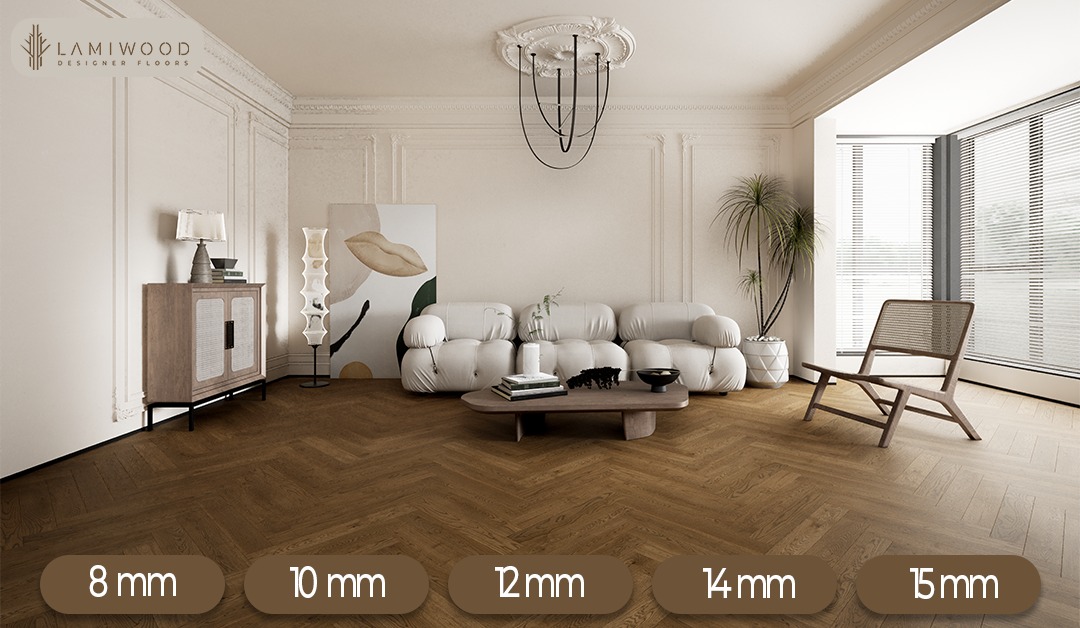Engineered wooden flooring has gained immense popularity in recent years, offering a blend of durability, aesthetics, and versatility. One of the key decisions when selecting engineered wooden flooring is determining the appropriate thickness. Let’s take a look, at what determines the thickness of engineered wood flooring discuss the benefits of thickness choices, and offer some advice to assist you in making a well-informed decision, for your area.
Understanding Engineered Wooden Flooring
Before delving into the thickness considerations, it’s essential to understand what engineered wooden flooring is and how it differs from solid hardwood. Engineered wood consists of layers of wood veneers stacked and bonded in a grain pattern. This unique design improves stability and minimizes moisture-related problems. Enables the production of plank sizes, than traditional solid hardwood.
Factors Influencing Engineered Wood Flooring Thickness
Several factors influence the choice of thickness for engineered wooden flooring:
- Subfloor Compatibility: The thickness of the flooring should be compatible with the existing subfloor conditions. When using planks you might need to make changes, to the door opening transitions, between rooms and the materials used underneath.
- Installation Method: The chosen installation method, whether floating, glue-down, or nail-down, may dictate the optimal thickness of the flooring. Thicker planks may be more suitable for nail-down installations, while thinner options are ideal for floating installations.
- Structural Stability: Thicker-engineered wooden flooring offers enhanced structural stability and durability, making it suitable for high-traffic areas or environments prone to temperature and humidity fluctuations.
- Acoustic Properties: The thickness of the flooring can impact its acoustic performance, particularly in multi-story buildings or spaces where sound insulation is a priority.
The Benefits of Various Thickness Options for Wooden Flooring
Wooden flooring that is engineered comes in choices usually varying from 3/8 inch to 3/4 inch. Each thickness has its benefits.
3/8 inch (10mm):
- Cost-effective option
- Best suited for places with low pedestrian traffic.
- Ideal for installations over existing flooring or in spaces with height constraints
1/2 inch (12mm):
- Versatile thickness suitable for most residential applications
- Offers a balance of affordability and durability
- Suitable, for installation approaches.
5/8 inch (15mm):
- More reliable than compared to other thinner options
- Great, for spots, like entrances, corridors, and family rooms.
- Provides improved sound insulation and underfoot comfort
3/4 inch (18mm):
- Premium thickness offering maximum durability and structural stability
- Great for business environments with high foot traffic and areas exposed to conditions.
- Provides superior sound insulation and a solid feel underfoot
Choosing the Right Thickness for Your Space
Selecting the optimal thickness of wooden flooring involves considering your specific needs, preferences, and budget. Here are some prominent tips that will help you a lot to make the right decision:
- Assess the Usage: Consider the level of foot traffic and the intended use of the space. High-traffic areas may benefit from thicker planks for added durability and longevity.
- Evaluate Subfloor Conditions: Take into account the condition of the existing subfloor and any height restrictions. Adjustments to door clearances and transitions might be necessary when using planks.
Prioritize Durability: If durability is a primary concern, opt for thicker engineered wooden flooring options, especially in areas prone to moisture or temperature fluctuations. - Select the Right Installation Method: Select a thickness that works well with the installation method you prefer. Thicker planks are usually best, for nail-down installations whereas thinner options are great, for floating installations.
- Budget Considerations: While thicker engineered wooden flooring may offer Consider your budget limitations. Align them with the features and specifications you aim for. superior durability and performance, it often comes at a higher cost.
Conclusion
Hence, the thickness of engineered wooden flooring plays a crucial role in determining its performance, durability, and suitability for different applications. By understanding the factors influencing thickness, exploring the advantages of various options, and considering your specific needs and preferences, you can confidently select the right thickness for your space. Whether you opt for a thinner option for a budget-friendly renovation or invest in thicker planks for enhanced durability and stability, engineered wooden flooring offers a versatile and stylish solution that can elevate any interior environment.
Discover more! Check out my latest blog post – What is EIR Flooring?

